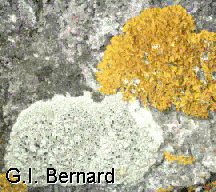
 Lichens
Lichens
Lichens are a symbiotic association between algae and fungus. The algae is a layer of single-celled plants
on the surface, just below a gelatinized layer of fungal hyphae. The algae captures nutrients that land on it's
surface and provide energy through photosynthesis, while the fungus absorbs moisture, and provides a
protective structure for the algae. These are otherwise independent organisms, capable of surviving without
each other. Lichens can insert threads a half inch into solid rock. These threads are not true roots, but
anchors. The fungus produces a potent acid, which is combined with an alcohol from the algae to form acid
crystals. The varied and often bright colors of the lichens come from these acid crystals. The acid is used to
etch holes in the rock, and threads are inserted for anchors (Platt). Most of the so-called "mosses",
especially those found in trees, are actually lichens. The true mosses are distinctively green like other true
plants.
 Lichens gather most of their nutrients through their surfaces, directly from the
air and rain. This habit gives the lichens an adaptability to live almost
anywhere, even on rocks, trees, or buildings. ... The Lichen Division is
comprised of at least 8 orders, 45 families, and 6,000 species. Information on
the edible and medicinal uses of the lichens is scattered. Many lichens are
known to have potent antibiotic properties, and many are edible. However,
some lichens do contain toxic substances, so you should not graze randomly on
them.
Lichens gather most of their nutrients through their surfaces, directly from the
air and rain. This habit gives the lichens an adaptability to live almost
anywhere, even on rocks, trees, or buildings. ... The Lichen Division is
comprised of at least 8 orders, 45 families, and 6,000 species. Information on
the edible and medicinal uses of the lichens is scattered. Many lichens are
known to have potent antibiotic properties, and many are edible. However,
some lichens do contain toxic substances, so you should not graze randomly on
them.
- Gyrophora -Rock Tripe
- The lichen is edible, especially when boiled with meat (Sturtevant).
-
- Umbiliceria-Rock Tripe
- This lichen is edible cooked. Soaking in a couple changes of cold water will help to remove the
bitterness. They are said to be mucilaginous, great for thickening stews (Angier). It also has antibiotic
properties (Angier).
-
- Lecanora-Cup Moss, Manna
- The plants are edible (Sturtevant). One species, growing in the middle-east is the "manna lichen".
During drought years the plant may be broken apart by the wind and blown across the land. This lichen
became immortalized in the Bible when it showered down on the starving Israelis as the "manna rain".
-
- Cetraria-Reindeer Moss
- Reindeer moss is bitter, antibiotic, and edible. The lichen is used as an expectorant to stimulate the
release of phlegm, apparently due to the bitterness. This bitterness needs to be removed to make the
plant edible. The lichen should be soaked over-night and for most of a day, in two changes of cold
water to remove the acids, then strained and eaten (Angier). It is a source of gelatin (Asch).
-
- Alectoria-Black Tree Lichen
- The black tree lichen is stringy and "moss" like. Montana Indians washed and soaked the lichen, then
cooked it for one to two days in a steam pit. The cooked lichen was eaten or dried and powdered and
used as a mush or thickener later. It is reported thatFlathead Indian families ate 25 pounds of the lichen
each year (Hart).
-
- Evernia
- The plant is edible (Sturtevant). A thick tea is used on running sores (Murphey).
-
- Letharia-Wolf Lichen
- This bright yellow tree lichen contains a highly toxic acid. It was once combined with animal fat and
nails and used in Europe to kill wolves (Vitt). It is also used as a dye plant.
-
- Usnea-Old Man's Beard
- The lichen is boiled for use as a dye (Gilmore). It is used medicinally as an antibiotic (Klein). (Usnea
is a light grey color. Use the "rubberband" test for positive identification: break the stems and inside
you will find a white, rubbery core that stretches a little like a rubberband.)
-
- Sticta
- The lichen is edible (Sturtevant).
-
- Claydonia-Pixie Cup Lichen
- The Cladonias contain didymic acid, used as an antibiotic against tuberculosis (Mabey). It is reported
to be edible (Sturtevant).
-
- Cladina-Reindeer Lichen
- Some species were boiled and the tea was taken for colds or as a laxative.
Thomas J. Elpel
[email protected]
Hollowtop Outdoor Primitive School
Pony, Montana
[email protected]



![]()
 Lichens gather most of their nutrients through their surfaces, directly from the
air and rain. This habit gives the lichens an adaptability to live almost
anywhere, even on rocks, trees, or buildings. ... The Lichen Division is
comprised of at least 8 orders, 45 families, and 6,000 species. Information on
the edible and medicinal uses of the lichens is scattered. Many lichens are
known to have potent antibiotic properties, and many are edible. However,
some lichens do contain toxic substances, so you should not graze randomly on
them.
Lichens gather most of their nutrients through their surfaces, directly from the
air and rain. This habit gives the lichens an adaptability to live almost
anywhere, even on rocks, trees, or buildings. ... The Lichen Division is
comprised of at least 8 orders, 45 families, and 6,000 species. Information on
the edible and medicinal uses of the lichens is scattered. Many lichens are
known to have potent antibiotic properties, and many are edible. However,
some lichens do contain toxic substances, so you should not graze randomly on
them.